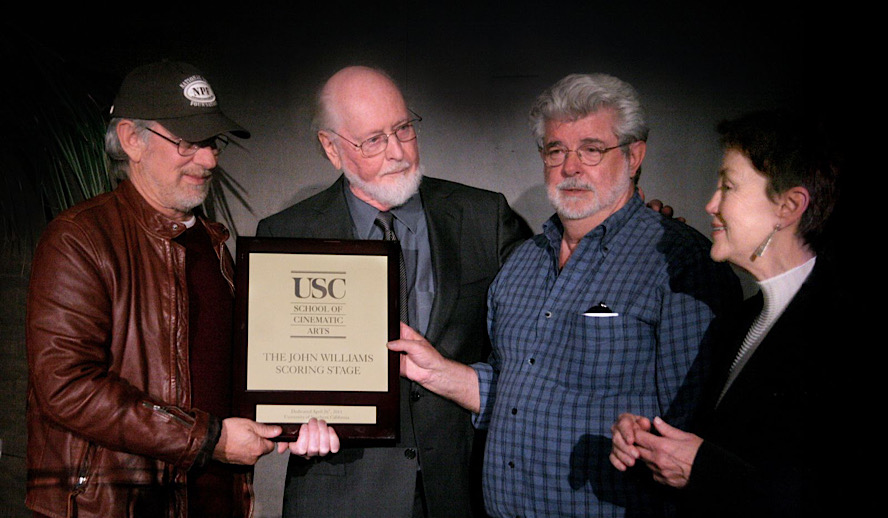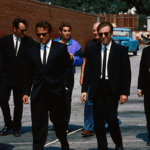Table of Contents

Photo: Steven Spielberg and George Lucas
After graduating from a school that has many majors focused on Cinema and filmmaking, there was a common thread that no matter what classes were taken or which professor taught that semester the same films were thrown onto the projector. This list of films will guarantee you to be a professor’s favorite and help understand the history of Cinema. As each film is discussed as to why it is important to view, other films will be mentioned that have directly been affected by these prior films and accomplish similar actions.
Related article: ‘In the Heights’ – Behind the Scenes and Full Commentary/Reactions from Cast & Crew
Related article: A Tribute to Cannes Film Festival: A Celebration of Cinema, Glamour, and Humanity | Statement From The Hollywood Insider’s CEO Pritan Ambroase
Film School Advice: Must-Watch Movies
‘A Trip to the Moon’ (1902)
This twelve-minute classic put Georges Méliès on the map for being one of the first film directors. This French illusionist is to thank for the iconic image of the moon with a face and a rocket sticking out of its eye. Many people are able to recognize it, but only a few are able to place the scene. This film could be considered the first sci-fi film which features space, smiling stars, and of course aliens. ‘A Trip to the Moon’ is a silent film, the incredible set design and costumes help tell the story of a group of astronomers in wizard hats who build a rocket and land it on the moon.
With smoke tricks, optical illusions, and the magic of editing, Méliès shocked audiences with his film in France. His early developments in the film helped shape the early days of narratives and what can be achieved. Other notable Méliès films that show off his magic skills are ‘The Man with the Rubber Head’, ‘The Vanishing Lady’, and ‘The Cook in Trouble’.
To think of where Cinema is now in terms of special effects is completely mind-blowing to the audiences of early films. Rather than watching the latest Marvel movie or latest Star Wars installment to compare the difference in technology that is now being used, a fun watch would be ‘Hugo’. The story of an orphan clock worker on the hunt to find out why his father left him a broken automaton and a sketch-filled notebook with the help of a toymaker’s daughter. Martin Scorsese’s 2011 film is an ode to Georges Méliès and is based on the illustrated book The Invention of Hugo Cabret. Viewing both of these films are perfect bookends for cinephiles.
‘A Trip to the Moon’ can be viewed here.
‘Hugo’ can be streamed on Netflix here.
Related article: MUST WATCH – The Hollywood Insider’s CEO Pritan Ambroase’s Love Letter to Black Lives Matter – VIDEO
Subscribe to The Hollywood Insider’s YouTube Channel, by clicking here.
‘The Cabinet of Dr. Caligari’ (1920)
Film students, let me introduce you to Fritz Lang, the front runner for German Expressionism. There have been many different movements in Cinema from various countries, but one movement that film schools love to analyze is German Expressionism. Though Lang did not direct the exemplary film, ‘The Cabinet of Dr. Calagari’, he is known for the other notable films ‘Metropolis’ and ‘M’ that are also key films for the movement. Robert Weine is to thank for this fever dream of a film. With an unforgettable set design with sharp points and harsh shadows, the film twists, and winds following a man who visits a strange doctor’s carnival exhibit. A somnambulist who is awakened to give prophecies to those who come along.
German Expressionism was a movement created during the 1920s where filmmakers rejected the will of realistic cinema and embraced the exaggerated. World War I was occurring which made filmmakers less amped to portray uplifting and happy films resulting in this distorted style of Cinema. The insane visuals in these films represent the inner monologue and fear of the people of Germany. A cinematic movement represents the culture of the people that are in the present, being able to connect more with the screen rather than using it as a simple escape.
Many films use this method nowadays, reflecting what is changing in the now with their art. Though it would be difficult to watch a modern film that substitutes German Expressionism because of its significance with being in that era, modern-day filmmakers are still influenced by the style that is created. A heavy-weight example being Tim Burton, the darkness and almost distorted worlds created can be easily traced back to Weine and Lang. Some classic Burton films that especially show this are ‘Batman’, ‘Corpse Bride’, and ‘Sweeney Todd’.
‘The Cabinet of Dr. Caligari’ can be viewed here.
Limited Time Offer – FREE Subscription to The Hollywood Insider
‘Battleship Potemkin’ (1925)
This intense silent film holds a scene that has been used again and again in pop culture references and a list of other films. To start, ‘Battleship Potemkin’ is a superb example of the movement Soviet Montage, and was directed by Sergei Eisenstein. Rather than relying on set design to show the inner turmoil of the filmmaker, it relied on heavy editing. Soviet Montage wanted their cutting to be apparent to the eye rather than smooth and invisible. Through editing, the story unfolds.
To get an even deeper understanding when viewing this film, taking one step back and learning about the Kuleshov Effect will get students started on the right path. This effect, created by Lev Kuleshov, was discovered when he realized he was able to tell a story with editing rather than acting out what is happening. In other words, trusting the audience to connect the dots. Believing that the audience would be able to fully understand a narrative without spelling it out.
‘Battleship Potemkin’ is about a Russian Mutiny that takes place on a ship and then moved to land with civilian support that turns violent by police. The famous scene that still holds value is the image of a baby stroller rolling down the Odessa steps. A mother reaches for her child during the massacre but is too late to catch the rolling carriage. This reference can be seen in other films such as ‘The Untouchables’, and even a Halloween episode of ‘The Simpsons’.
One of the greatest films that are known for its editing is Francis Ford Coppola’s ‘Apocolypse Now’. There are a million places to start with the magnificence of that film, but it shows the influence of Soviet Montage throughout it. The opening scene itself of Willard (Martin Sheen) being juxtaposed with the bombs in Vietnam show the inner struggle and trauma of the war. It is never said or acted out as so, but through editing, that message is clearly conveyed to the audience.
‘Battleship Potemkin’ can be viewed here.
‘Apocolypse Now’ can be viewed here.
Related article: The Hollywood Insider’s CEO Pritan Ambroase: “The Importance of Venice Film Festival as the Protector of Cinema”
Related article: The Masters of Cinema Archives: The Hollywood Insider Pays Tribute to ‘La Vie En Rose’, Exclusive Interview with Director Olivier Dahan
Related article: – Want GUARANTEED SUCCESS? Remove these ten words from your vocabulary| Transform your life INSTANTLY
‘Citizen Kane’ (1941)
It goes without saying that of course Orson Welle’s classic ‘Citizen Kane’ had to be on the list. From personal experience, I watched this film three times during my college career. This makes it an absolutely necessary watch for students pursuing film. For those who may know the famous term “Rosebud”, but never got around to watch the 1941 hit, it is the lifelong story of a wealthy publisher Charles Foster Kane. Welles directs and stars as Kane in this epic that follows a journalist who is on the hunt for the meaning of Kane’s last word “Rosebud”. The reporter interviews Kane’s survivors that knew him well and reveals everything from his childhood to his old age.
What makes this one of the most praised films of all time in Cinema has a lot to do with Welles himself. He was a popular radio man whose stardom continued to grow making the release of Citizen Kane even greater. Cinematically what this film does is break boundaries and create cinematography that rocked filmmakers’ worlds. One of them being a crane shot that looks like it enters through a glass window, another being the first to do a worm’s eye view during a dance sequence.
Hollywood has an obsession with the American dream. Through Cinema and literature, the American dream seems to be an underlining theme in most classics that are still praised today. ‘Citizen Kane’ is the definition of a man trying to reach the American dream, but realizing he is all alone in the end with all the things he’s wanted. A successful modern film that could be compared to Welle’s masterpiece is the 2010 David Fincher hit, ‘The Social Network’. Telling the rise and “fall” of the Facebook creator Mark Zuckerberg can draw similar connections to Kane. Creating a protagonist that is difficult to root for and striving to be the best of the best no matter the cost. Aaron Sorkin’s dialogue takes the story to the next level creating a rhythm throughout that a viewer could tap their foot along to. Showcasing this film in schools could be just as beneficial to students as Welle’s film.
‘Citizen Kane’ can be viewed here on HBO Max.
‘The Social Network’ can be viewed here on Netflix.
Related article: 5 Great Actors and their Acting Tropes – Marlon Brando, Katharine Hepburn, Daniel Day Lewis & More
Related article: Examining the 10 Best American Films From the AFI’s “100 Years…100 Movies” List
‘Vertigo’ (1958)
Last, but certainly not least is Alfred Hitchcock’s ‘Vertigo’. This lesser-known (compared to more of his mainstream classics) film really changed the direction of cinema and paved a new path for directors. Starring James Stewart as a struggling ex-cop who becomes obsessed with a beautiful woman, Kim Novak, and he thinks he sees her everywhere. Included in this mystery thriller is the “vertigo shot”; in Stewart’s character’s last day on the job, Scottie has a case of vertigo that makes him get an extreme fear of heights.
To convey the dizzy feeling to the audience, Hitchcock came up with the idea of combining a camera zoom and dolly shoot; as the dolly moves backward away from the subject the lens of the camera zooms in on the subject. This creates a dizzy effect for the viewer and the subject stays the same size while the background becomes more distorted. A famous version of this was used in Steven Spielberg’s ‘Jaws’. The beach scene when Chief Brody hears someone scream shark. The distortion of the shot gives the audience a focused sense of anxiety without exactly pinpointing the reason why.
Yes, that shot is noteworthy to film students, but it is not the main reason why ‘Vertigo’ is shown in classrooms. The auteur theory really blossomed when evaluating this film. The basicness of the theory is that the director is the creative mastermind of film. They are the artist and make the film what it is. It may seem like a generic thought, but it put the director’s on the map of being the head creative in the industry. Another way of looking at it is looking at the director’s filmography. It’s easy to tell that Hitchcock was the director of a film compared to other directors at the time. Directors started making their mark and creating their own artistic style on their films.
Related article: The Best Movies of EACH Decade from the 1930s Onwards
Related article: Powerful Director-Actor Partnerships: A Look at the Greatest Cinematic Duos
One of the best examples of that is Wes Anderson. Only from a few shots, people are able to guess that Anderson was the mastermind behind it. His films including ‘Grand Budapest Hotel’, ‘Moonrise Kingdom’, and ‘Fantastic Mr. Fox’ all have the same cinematic style though completely different storylines. Anderson takes symmetry and balance very seriously when composing his shots and the tempo of his films is also on the same beat. Anderson is the artist behind his films creating them as something that no other director can take credit for. A true example of the auteur theory.
‘Vertigo’ can be viewed here on Amazon Prime.
Wrap Up
All of these films above are shown for a very good reason and will continue to be shown to future generations of filmmakers. Without these foundational films, it is hard to tell where Cinema would be and what it would represent. It is important to remember where we started and thank the early artists that had enough passion and love for film to break boundaries and try new things. Good luck in film school!
By Jack Colin
Click here to read The Hollywood Insider’s CEO Pritan Ambroase’s love letter to Black Lives Matter, in which he tackles more than just police reform, press freedom and more – click here.
An excerpt from the love letter: The Hollywood Insider’s CEO/editor-in-chief Pritan Ambroase affirms, “The Hollywood Insider fully supports the much-needed Black Lives Matter movement. We are actively, physically and digitally a part of this global movement. We will continue reporting on this major issue of police brutality and legal murders of Black people to hold the system accountable. We will continue reporting on this major issue with kindness and respect to all Black people, as each and every one of them are seen and heard.
Just a reminder, that the Black Lives Matter movement is about more than just police brutality and extends into banking, housing, education, medical, infrastructure, etc. We have the space and time for all your stories. We believe in peaceful/non-violent protests and I would like to request the rest of media to focus on 95% of the protests that are peaceful and working effectively with positive changes happening daily. Media has a responsibility to better the world and The Hollywood Insider will continue to do so.”
Ways to support Black Lives Matter Movement to end systemic racism
More Interesting Stories From The Hollywood Insider
– Want GUARANTEED SUCCESS? Remove these ten words from your vocabulary| Transform your life INSTANTLY
– Compilation: All James Bond 007 Opening Sequences From 1962 Sean Connery to Daniel Craig
– Do you know the hidden messages in ‘Call Me By Your Name’? Find out behind the scenes facts in the full commentary and In-depth analysis of the cinematic masterpiece
– A Tribute To The Academy Awards: All Best Actor/Actress Speeches From The Beginning Of Oscars 1929-2019 | From Rami Malek, Leonardo DiCaprio To Denzel Washington, Halle Berry & Beyond | From Olivia Colman, Meryl Streep To Bette Davis & Beyond
– In the 32nd Year Of His Career, Keanu Reeves’ Face Continues To Reign After Launching Movies Earning Over $4.3 Billion In Total – “John Wick”, “Toy Story 4”, “Matrix”, And Many More
Film school, Film school, Film school, Film school, Film school, Film school, Film school, Film school, Film school, Film school, Film school, Film school, Film school, Film school, Film school, Film school, Film school, Film school, Film school, Film school, Film school, Film school, Film school, Film school, Film school, Film school, Film school, Film school, Film school, Film school, Film school, Film school, Film school, Film school, Film school, Film school, Film school, Film school, Film school, Film school, Film school, Film school, Film school, Film school

Jack Colin is a playwright and screenwriter with an immense love for film & television which drives him to learn from and share his passion with anyone willing to listen. Living life as a trans man, Jack wants his writing to create a safe space for LGBTQ+ members and share the positive stories that are so often ignored through his work at The Hollywood Insider, he is eager to give readers a confident outlook on life. The storytellers of the world are the ones who decide what happiness can be. Jack takes pride in The Hollywood Insider’s mission statement to stray away from gossip and to lift up voices in entertainment with supportive and meaningful stories that will promote strength and unity.








